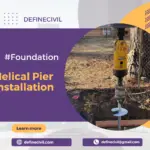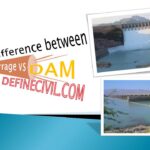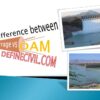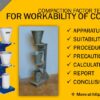All structures have some kind of foundation which safely carries loads from the structure to the ground. Foundation is the most critical part of any structure and due we need to take due measures to ensure its safety. Apart from structural requirements, a proper drainage system is the key factor which ensures proper functioning of a foundation.
Presence of excessive moisture can jeopardize the safety and serviceability of a foundation which ultimately affects the whole structure.
We can make a foundation watertight with interior waterproofing measures or exterior drainage. Anyhow, for interior waterproofing we can design damp proof courses at plinth level, or covering foundation with waterproofing chemicals or sheets.
Also Read: What is meant by Lean to Roof – Advantages and Disadvantages
Exterior waterproofing measures include providing a drainage system around the foundation which drains off water away from the foundation.
The most common types of exterior foundation drainage systems are:
Types of Foundation Drainage
- French Drain.
- Footing Drainage.
- Grading Drainage.
- Sum pit and pumps.
In this article, we will discuss about exterior foundation drainage, different types of foundation drainage, its importance and methods used to provide an efficient drainage system.
What is Foundation Drainage?
Foundation drainage refers to any system that works along with a foundation for the purpose of drainage. It essentially prevents accumulation of water around the foundation and safely carries it to some remote point without undermining the stability of the foundation.
Mostly contractors lay this drainage system simultaneously with the footing during the construction phase. Anyhow, it is common practice to install foundation drains using trenchless technology with minimum disturbance to surface topography.
So, if you’re thinking to install a foundation drainage system and are bit worried for the annoyance of knocking down some walls; you don’t have to worry at all. Modern methods and techniques help having such systems installed with minimum disruption.
Whether it is the ingress of water due to ground water table rise of accumulation of water due to rain, a foundation drain collects that water and drains it somewhere else away from the structure.

Importance of Foundation Drainage
- If there is persistent accumulation of water around a foundation, it may lead to settlement of soil on which the foundation is laid. This will cause the building to settle.
- Presence of water may trigger the erosion of soil and the soil may get washed away with the running water which undermines the safety of foundation and ultimately structure.
- Moisture presence is almost always accompanied by termite attack. Moist conditions are ideal for the growth of termites. Termite attack can soon progress into the building.
- Water around foundation can find its way into the foundation through tiny fissures and cracks. This will progressively deteriorate the foundation. In case of concrete, it may lead to the corrosion of rebar.
- Water may rise through the walls by the phenomenon of capillary tension. This will lead to condensation problem, mold growth, deterioration of paint or wood work.
Types of Foundation Drainage
Based on the location of drain and its functional characteristics, we can divide foundations drains into following categories.
French Drain or Weeping Drain
A french drain is a pipe which has small perforations on its surface which allow the water to enter the drain pipe. A french drain is the most commonly used drain pipe to provide drainage around a foundation. It is covered with porous backfill which creates passage for the water to pass through and ultimately reach the pipe.

Footing Drainage
It consists of a french drain that is going around the perimeter of a footing. It goes along the foundation while covering with porous material, like gravel or coarse sand. This porous back-fill allows water to seep through and reach the pipe.
The perforations in the drain pipe further allows the water to weep through and enter the pipe.
The drain pipe goes along suitable slope that runs away from the building. The water collected in the drain pipe is ultimately drained off away from the building. The diameter of drain pipe is selected according to design requirements. Usually, 4″ diameter pipes are used. However, size can be increased depending on requirements.
The problem with footing drainage is that drain pipes may get clogged due to mud accumulation around the pipes.
It can be seen in the picture above that the stone pad provided above and around the perforated drain pipe is free of fine material.
As mentioned earlier, this is done to provide continuous voids in the stone pad for water to pass through and enter the pipe and ultimately drain off.

Grading Drainage
Grading drainage is the simplest and most efficient way of providing drainage around a foundation. It involves providing a slope around the perimeter of a building that runs away from the foundation.
The slope provided will immediately drain off excess water away from the building. In grading drainage system, the problem of clogging is also avoided as it does not depend on a pipe system for drainage.

Sump Pits and Pumps
A sump pit is a hole with a gravel base dug into the lowest part of basement or crawl space. It is accompanied by a pumping system.
Also Read: What is wellpoint system? Types – Applications – Advantages
A sensor is always attached with the pump. So, when water enters the sump pit, the sensor automatically turns the sump pump on. But then the pump moves the water away from the building through pipes.
With that, the sump pump needs electricity to work and sometimes battery backups are also installed to ensure continuous working. A check valve is also installed to prevent back flow of water.

Advantages and Disadvantages of Foundation Drainage
Advantages
- Foundation drainage ensures stability of a structure by preventing the settlement of foundation.
- It reduces erosion of soil from around the perimeter of a foundation. If erosion occurs, support for foundation will be lost and it may settle or ultimately fail.
- It prevents dampness in the building which might be induced by consistent accumulation of water.
- It helps maintaining a foundation in good condition.
A good foundation drainage adds to the life of a structure.
Disadvantages
- Foundation drainage requires costly maintenance.
- The initial cost of installing foundation drainage is high.
- Foundation drainage may get clogged over time leading to costly repair works.
- It requires skilled labor.
Foundation drainage cost
Are you wondering how much a foundation drainage system cost?
Well, a French drain foundation system will cost you about $1,000 to $10,000 per 100 linear feet. To that, it depends on the length of the foundation and the depth. A trench channel or an underground downspout costs you less. Underground downspouts will be around $200 to $2,000 per downspout. A concrete catch basin or a storm drain will be around $2,000 to $5,000 per basin.
Further read: Foundation Failure – (Read it before its TOO Late)




















